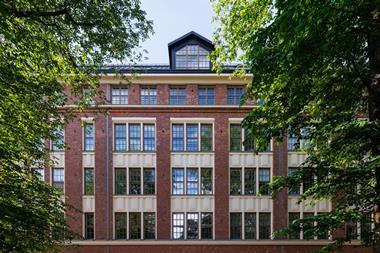Uncertainty has slowed activity but, despite a poor year for real estate, strategic allocations have not been cut and some have even increased, Gail Moss finds
Over the past year, one issue has dominated the real estate asset class for Belgian pension funds - the poor returns from a sector hit by the credit crunch and fears of global recession. According to the latest Pension Investment Performance Survey by Mercer in Brussels, Belgian pension funds suffered a median total loss of 18.9% from the sector for the 2007 calendar year.
This followed a succession of bumper years, with returns of 48.5% for 2006, 22.9% for 2005 and 25.6% for 2004, according to the same survey, which covers Belgium's 100 biggest pension funds.
Belgian law does not place any restrictions on investing in property by pension funds, as long as it provides good diversification and is prudently carried out.
"The average allocation to real estate by these pension funds is only 3%, mostly in quoted stocks," says Willy Santermans, actuary at Mercer in Brussels. "However, I don't expect this to change much. After five years of very good figures, it is still a worthwhile investment."
Chris Desmet, senior investment consultant, Watson Wyatt, Brussels, agrees. "Belgian pension funds invest in real estate in order to diversify away from equities, to stabilise returns over time," he says. "And the key criterion for most Belgian pension funds is total return. Generally, they do not hold property for rental income, as pensions are almost always paid out as lump sums rather than annuities."
But Desmet adds, "Even though returns were very bad last year, pension funds have not changed their strategic asset allocation to real estate - indeed, there were even some increases for diversification purposes."
In Belgium, only the very large funds hold real estate directly, the vast majority prefer to invest via property funds. Desmet says: "You need a large outlay to begin with. So for a pension fund portfolio of €100m, a 10% real estate allocation would be €10m, which would only buy you one building. And that is not good diversification."
In terms of sector allocation, Desmet says Belgian funds tend to follow the benchmarks, for example, those from EPRA, the European Public Real Estate Association, and Petercam, the investment
managers.
He says: "Generally, there are some good mutual funds available, and this makes things very straightforward from an administration point of view. However, pension funds sometimes find the fees are too high."
One trend which Desmet highlights is a more adventurous attitude to geography; most investments are still concentrated within Europe, including the UK, but he says that some of the bigger funds are now moving into global real estate.
"A number of pension funds reduced their real estate holdings in 2007," says Carl Vanlerberghe, secretary, Pensioenfonds UZ-Gent. "We did as well in February last year since, as a result of the excellent performance in 2006 and in January 2007, real estate had reached a level of over 13% in our
portfolio."
The €210m-worth fund's strategic asset allocation to real estate is 10%, and its statement of investment principles stipulates that the real estate allocation must be adjusted if the percentage goes above 12% or under 8%.
Vanlerberghe says: "A lot of other funds also sold holdings to take profits on the gains made over the last few years. We believe that Belgian pension funds want to reinvest in real estate as soon as the markets become more stable again. We have heard that some funds have already started reinvesting."
The fund's specialised real estate mandate started on 1 July 2005, investing exclusively in a fund that invests in shares of real estate companies listed on European stock exchanges. Geographically, the biggest holdings are in the UK, France, Austria and Belgium.
The annualised return of the real estate portfolio between then and 31 December 2007 was 6.8%, compared with a benchmark return of 4.9%. However, last year the portfolio lost 25.3%, compared with a benchmark loss of 28.6%. The first quarter's performance for 2008 is estimated at about -4.5%.
Vanlerberghe says: "The fund's board decided only to invest in funds, not individual shares. The main reason for this was to control bookkeeping costs. In terms of the new Belgian legislation on pension funds, this may not always be the most tax-efficient way of doing things, as tax paid overseas cannot be recouped, but recording and following up individual shares costs a lot in manpower."
At present, the fund has no plans to change its strategic asset allocation. Vanlerberghe says: "In a few years, we expect to perform a new ALM study to see if we have to adjust our strategic asset allocation, and perhaps also diversify to non-European real estate. Our main challenge at present, however, is coping with a possible recession."
The €10bn ETHIAS pension fund has 2-3% of its portfolio invested in property, and hopes to increase this gradually to 5% over time.
By far the biggest holding is a 6% stake in
Banimmo, a listed property company whose main activity is to renovate office buildings and sell them on. Its portfolio is concentrated in large cities in Belgium and France, and includes two conference and resort centres, in partnership with US hospitality company Dolce International.
Jean-Paul Parmentier, chief financial officer, ETHIAS, says: "We started in property funds two years ago. It is expensive to build an in-house team, so the idea was to buy into funds managed by professionals, and learn from them."
Unusually for most Belgian pension funds,
ETHIAS holds real estate largely for the yield, because of the volatility of stock market prices. Banimmo is currently offering a 6% gross yield, which Parmentier considers to be a minimum.
ETHIAS also has smaller holdings in other funds run by managers including
Cofinimmo - another Belgian listed company running rental office portfolios - and Montea, a property company in the industrial and logistics sector, as well as some very small direct holdings.
As a whole, however, its real estate portfolio is dominated by the office sector, because, says Parmentier, this is considered to be the most
stable sector, while offering the best risk/return ratio.
However, ETHIAS is trying to increase its direct property holdings. It already owns a couple of office buildings in Brussels. "We are planning to grow the direct holdings very slowly," says Parmentier. "We are closely related to public authorities in Belgium, and if they have buildings they want to sell, we will try to buy them and keep them on as tenants. But prices will have to come down a bit first."
This suggests a rather gloomy view of the
economic climate.
But Desmet does not think this will necessarily affect real estate investing. He says: "Belgian pension funds are concerned about the economic outlook, but not overly so. As 2008 is not expected to be a good year, they will start to look at individual asset classes within the context of the total return of the fund. But this does not mean they will reduce their real estate allocation, especially if it is seen as providing diversification."












